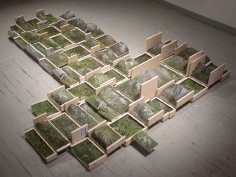Katrin Sigurdardottir
卡特琳·西于尔扎多蒂
КАТРИН СИГУРДАРДОТТИР
source: moussemagazineit
Sigurdardóttir’s predominantly sculptural practice focuses on the adapted representation, modification and containment of time, space and place – a practice whose greater intention is to eschew a conventional approach by the viewer. With architecture and landscape as sources, the artist’s sculptures use scale and distortion to focus attention on the space and perception between the viewer and the object. Using the vernaculars of architecture and topography, Sigurdardóttir creates objects with a prismatic spirit that fractures a viewer’s perspective.
Titled “Ellefu” – Eleven in Icelandic – Sigurdardóttir’s show includes three intimately scaled hydrocal and basswood constructions portraying interior segments of her childhood home in Reykjavik, located at Langahlíð 11. With photographs and memory as departure, the artist systematically cross-sections the rooms and chambers to reveal not only fragments but vessels of times past. Low to the floor, the three constructions appear like axonometric drawings from eye level but the porous, handmade material approach belies the vector-like simplicity of the sculptural forms. The ambiguously Lilliputian rooms, stairwells and hallways, intentionally abstracted and emptied of all detail, encourage movement in the round, allowing the viewer to furnish the spaces with his or her own recollections while remaining tempered by the fragility and sense of redress inherent to the materials.
.
.
.
.
.
.
.
source: interviewmagazine
Katrín Sigurdardóttir’s sculptures and installations redefine preconceptions surrounding architecture, history, and memory. Her work is defined by lack of presence: rooms without people or color, and interiors pared down to anonymous essentials that quietly exist as markers of the artist’s specific memories. In 2003’s Impasse II, for example, the artist recreated the façade of her childhood elementary school as a miniature. Without any specific reference to location, or details, the piece appears almost as an architectural study—its poetics only revealed upon the acquisition of background information.
Sigurdardóttir often employs exacting processes like cartography or architectural model making into her work, but the tension lies in the inexact nature of what she is rendering. In this way, Sigurdardóttir is less concerned with the language of architecture than with the architecture of language, with fluid nuances and room for reinterpretation and projection. In 2012’s Stage, the artist displayed a miniature theater stage, suspended in an empty storefront and illuminated by a spotlight. It is this masterful control of information, which renders in viewers an empty hollowness, at once lovely and intriguing.
Currently based in New York, Sigurdardóttir will be representing Iceland at the 55th Venice Biennale, opening in June. It is a well-deserved honor for the artist, who has exhibited, lectured, and diligently and prolifically created at a diverse array of venues, including the Metropolitan Museum of Art, MoMA PS1, and Art in General.
.
.
.
.
.
.
.
source: bombsite
Katrín Sigurdardóttir is a New York–based Icelandic artist whose sculptures and installations explore entanglements of body, perception, and memory. I first met Sigurdardóttir in January of 1998, shortly after I arrived in Iceland on a Fulbright grant. I remember sitting on the floor of the artist’s Reykjavík flat as she opened a small wooden case and began removing shallow wood boxes, each containing a miniature landscape. Just when I thought she was finished, another landscape would emerge. The nested landscapes—17 in all—reproduced public parks in cities where she’d lived (including San Francisco, New York City, and Reykjavík). Sigurdardóttir’s work—with its conflation of home and public space—sparked a conversation, ongoing still, about sculpture and experiences of place.
Over the years, Sigurdardóttir’s work has repeatedly explored the relationship between embodied experiences of place and imaginary or conceptual constructions of space. The artist often uses hobbyist miniatures or architectural models to set up contrasts in scale. High Plane V (2007), at MoMA PS1, was a large structure with steps leading to a platform through which the viewers poked their heads into a landscape of mountainous islands. The visitors’ heads became part of the landscape and invaded the panorama of uninhabited nature. Home, as an elusive braiding of memory and fantasy, was evoked in the artist’s 2012 exhibitions at Eleven Rivington in New York City and Meessen De Clerq in Brussels with works from the series based on scale models of sections (facades, halls, doorways) of the artist’s childhood home on Langahlíð 11 in Reykjavík.
In 2010 to 2011, Sigurdardóttir’s site-specific project for the Metropolitan Museum, Boiserie, reproduced two of the museum’s 18th-century period rooms. The artist’s meticulous rendering of decorative surfaces was bleached of color and reduced in scale, conceptualizing the museumgoer’s encounter with historical objects. As Iceland’s representative at this year’s Venice Biennale, Sigurdardóttir’s project (which will travel from Venice on to Reykjavík and New York’s SculptureCenter) is an architectural intervention that furthers the artist’s interest in scale, embodied experiences of place, and the staging of views.


